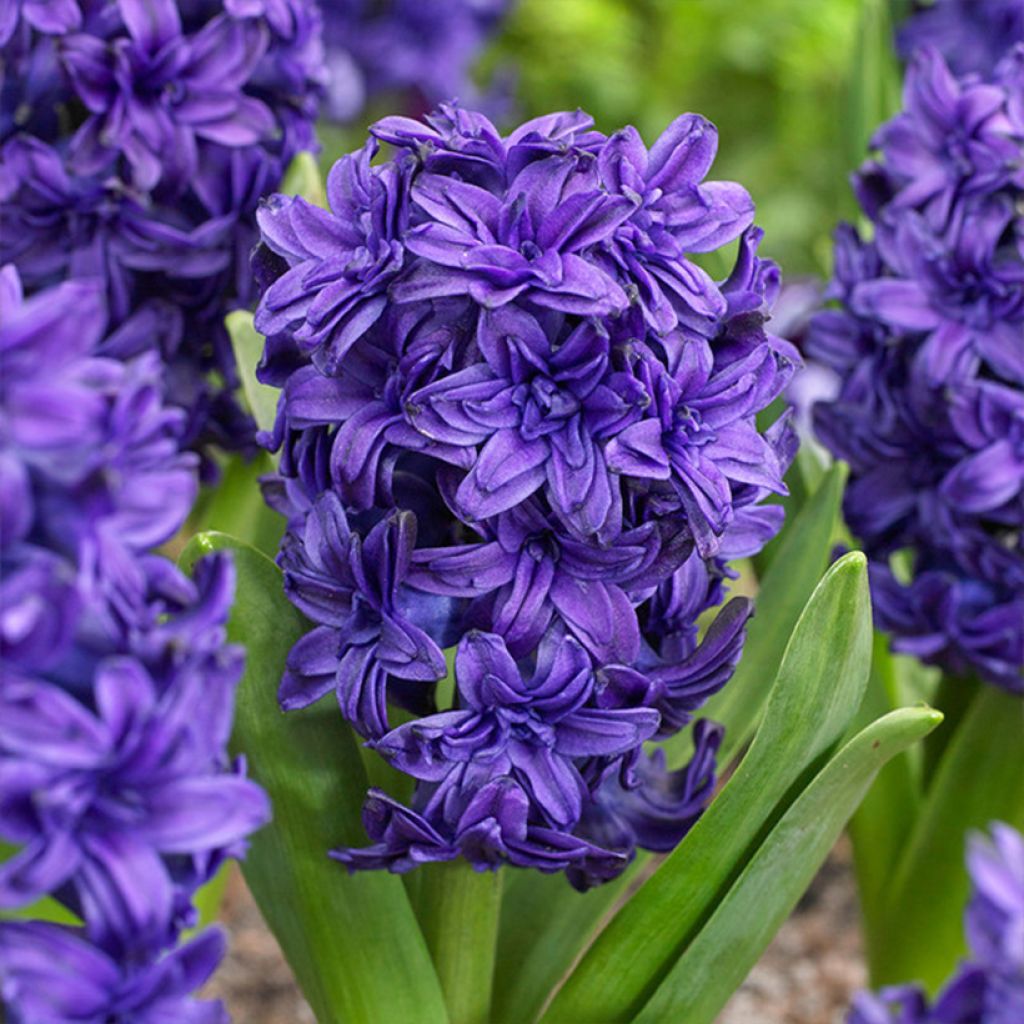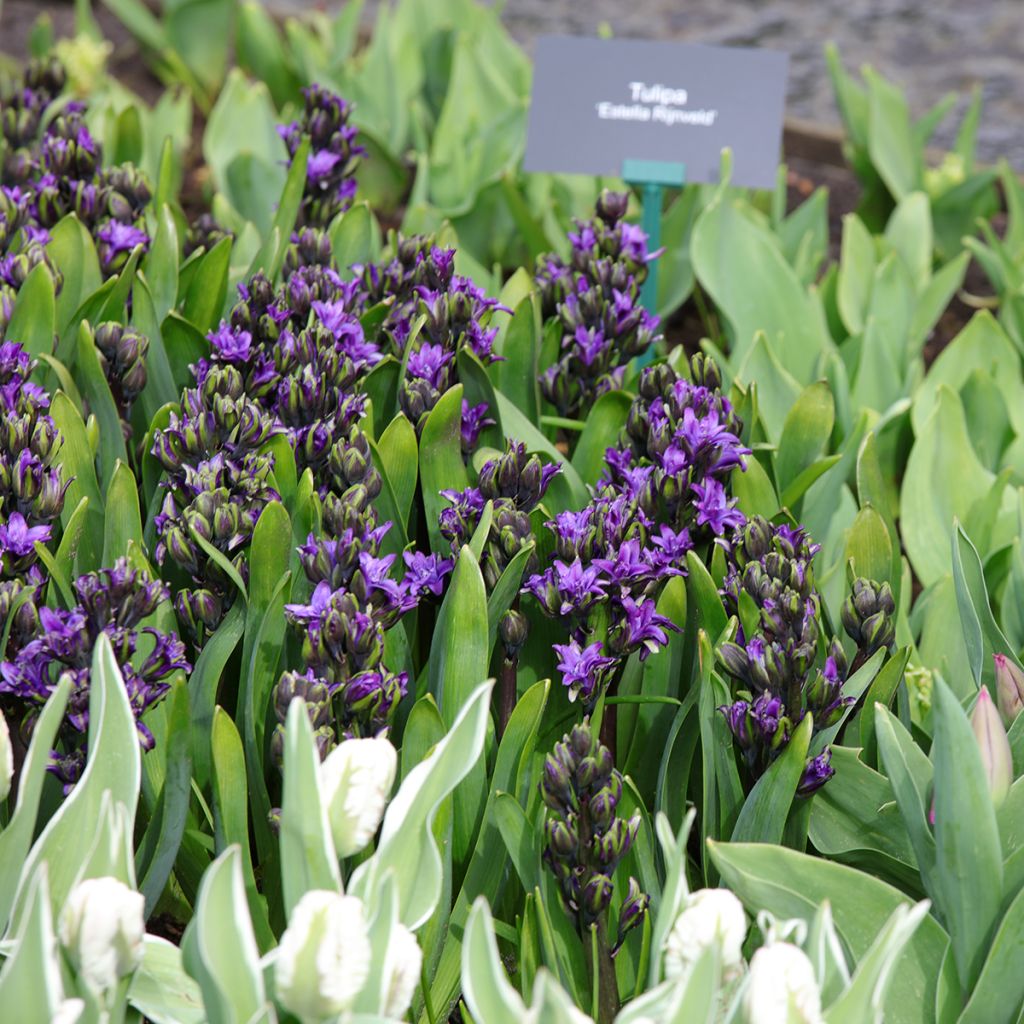

Hyacinthus Twin Pearl - Garden Hyacinth


Hyacinthus Twin Pearl - Garden Hyacinth
Hyacinthus Twin Pearl - Garden Hyacinth
Hyacinthus x orientalis Twin Pearl
Common Hyacinth, Garden Hyacinth
Bulbs received healthy and well packaged. Can't wait to see the result. Hyacinths and peonies are my favourite flowers, looking forward to receiving my next peonies order.
Geralde , 08/11/2024
This plant carries a 6 months recovery warranty
More information
We guarantee the quality of our plants for a full growing cycle, and will replace at our expense any plant that fails to recover under normal climatic and planting conditions.
From €5.90 for pickup delivery and €6.90 for home delivery
Express home delivery from €8.90.
Does this plant fit my garden?
Set up your Plantfit profile →
Description
Hyacinthus orientalis 'Twin Pearl' is a hybrid hyacinth with fully double flowers, in a deep blue tending towards violet, pleasantly scented. Its beautiful clusters of star-shaped flowers in intense colours bloom from the end of March, or in April depending on the climate. This highly ornamental bulb is perfect for borders as well as flower beds, where it happily combines with lighter-coloured varieties to create stunning floral compositions.
The Oriental Hyacinth, a slender botanical species with small spikes of blue flowers, is no longer widely cultivated. It originated in the Middle East and Mediterranean regions. However, it has given rise to countless cultivars called Dutch Hyacinths, highly appreciated in gardens for their delightfully fragrant spring flowering or in floristry for their forcing ability.
Formerly classified among the Liliaceae, the genus Hyacinthus is now part of the Asparagaceae family, like asparagus, as well as Agave and Yucca. This plant has a large oval bulb and forms a clump of narrow, elongated, shiny green leaves. From March, a sturdy flower stem, 20cm (8in) long, emerges from the clump of leaves. It is covered with numerous small, fully open star-shaped flowers. Carried by short peduncles, the corollas that form a dense cluster measuring 8 to 10cm (3 to 4in) in diameter and about fifteen in length consist of 2 or 3 groups of petals. These small double flowers have a slightly purplish blue colour, reminiscent of certain bellflowers... Highly fragrant, the flowering is melliferous and attracts butterflies. It is accompanied by deciduous foliage, disappearing in summer and reappearing in late winter. It consists of bright green leaves, 15 to 35cm (6 to 14in) long. The hyacinth reaches a height of 25-30cm (10-12in) at maturity.
Highly appreciated for its early flowering, the hyacinth is one of the few bulbs with large flowers. The 'Twin Pearl' Hyacinth can be grown both in flower borders and in pots or vases. When planted in the ground, it will renew itself for several years, while in a pot, it will only last one season. Plant it in groups to create a mass effect and to create stunning scenes, combine it with other early bulbs such as Tripartite Daffodils whose lemon yellow flowers will contrast vividly with 'Twin Pearl's purplish blue. White or yellow Crocuses will also be good companions in this regard, as well as the small Urumiensis Tulips, a dwarf botanical species with yellow star-shaped flowers. In the background, plant low-growing shrubs that flower early to add volume to your flower bed. Chaenomeles speciosa 'Yukigoten' is a Japanese Quince that blooms with beautiful double white flowers at the same time as your Hyacinth. And to create a third vegetation zone, plant a Stachyurus praecox behind it, a charming and unfairly overlooked shrub that produces strings of small yellow bells early in the season and whose foliage takes on stunning colors in autumn.
Report an error about the product description
Plant habit
Flowering
Foliage
Botanical data
Hyacinthus
x orientalis
Twin Pearl
Asparagaceae
Common Hyacinth, Garden Hyacinth
Cultivar or hybrid
Planting and care
The 'Twin Pearl' Oriental Hyacinth thrives in the sun. You can also place it in a semi-shaded area. When grown in a pot, keep it away from drafts. Plant it from October to November, 10cm (4in) deep in a cool, light, and well-drained soil. If the soil is heavy, add sand during planting. The bulbs should be spaced 4 to 8cm (2 to 3in) apart. In very harsh climates, cover with litter to protect from extreme cold.
After flowering, when the leaves turn yellow and wither and you have cut off the faded flowers, dig up the bulbs and store them in a dry place until they are replanted in the following autumn. The second flowering will be less abundant, but still rewarding in a mass planting. Reserve a special place in the garden for hyacinths, as they are one of the few bulbs with large flowers that bloom early. Avoid excessive water in winter to prevent diseases such as gray rot. Other than that, this bulbous plant is resistant to diseases.
Planting period
Intended location
Care
-
, onOrder confirmed
Reply from on Promesse de fleurs
Haven't found what you were looking for?
Hardiness is the lowest winter temperature a plant can endure without suffering serious damage or even dying. However, hardiness is affected by location (a sheltered area, such as a patio), protection (winter cover) and soil type (hardiness is improved by well-drained soil).

Photo Sharing Terms & Conditions
In order to encourage gardeners to interact and share their experiences, Promesse de fleurs offers various media enabling content to be uploaded onto its Site - in particular via the ‘Photo sharing’ module.
The User agrees to refrain from:
- Posting any content that is illegal, prejudicial, insulting, racist, inciteful to hatred, revisionist, contrary to public decency, that infringes on privacy or on the privacy rights of third parties, in particular the publicity rights of persons and goods, intellectual property rights, or the right to privacy.
- Submitting content on behalf of a third party;
- Impersonate the identity of a third party and/or publish any personal information about a third party;
In general, the User undertakes to refrain from any unethical behaviour.
All Content (in particular text, comments, files, images, photos, videos, creative works, etc.), which may be subject to property or intellectual property rights, image or other private rights, shall remain the property of the User, subject to the limited rights granted by the terms of the licence granted by Promesse de fleurs as stated below. Users are at liberty to publish or not to publish such Content on the Site, notably via the ‘Photo Sharing’ facility, and accept that this Content shall be made public and freely accessible, notably on the Internet.
Users further acknowledge, undertake to have ,and guarantee that they hold all necessary rights and permissions to publish such material on the Site, in particular with regard to the legislation in force pertaining to any privacy, property, intellectual property, image, or contractual rights, or rights of any other nature. By publishing such Content on the Site, Users acknowledge accepting full liability as publishers of the Content within the meaning of the law, and grant Promesse de fleurs, free of charge, an inclusive, worldwide licence for the said Content for the entire duration of its publication, including all reproduction, representation, up/downloading, displaying, performing, transmission, and storage rights.
Users also grant permission for their name to be linked to the Content and accept that this link may not always be made available.
By engaging in posting material, Users consent to their Content becoming automatically accessible on the Internet, in particular on other sites and/or blogs and/or web pages of the Promesse de fleurs site, including in particular social pages and the Promesse de fleurs catalogue.
Users may secure the removal of entrusted content free of charge by issuing a simple request via our contact form.
The flowering period indicated on our website applies to countries and regions located in USDA zone 8 (France, the United Kingdom, Ireland, the Netherlands, etc.)
It will vary according to where you live:
- In zones 9 to 10 (Italy, Spain, Greece, etc.), flowering will occur about 2 to 4 weeks earlier.
- In zones 6 to 7 (Germany, Poland, Slovenia, and lower mountainous regions), flowering will be delayed by 2 to 3 weeks.
- In zone 5 (Central Europe, Scandinavia), blooming will be delayed by 3 to 5 weeks.
In temperate climates, pruning of spring-flowering shrubs (forsythia, spireas, etc.) should be done just after flowering.
Pruning of summer-flowering shrubs (Indian Lilac, Perovskia, etc.) can be done in winter or spring.
In cold regions as well as with frost-sensitive plants, avoid pruning too early when severe frosts may still occur.
The planting period indicated on our website applies to countries and regions located in USDA zone 8 (France, United Kingdom, Ireland, Netherlands).
It will vary according to where you live:
- In Mediterranean zones (Marseille, Madrid, Milan, etc.), autumn and winter are the best planting periods.
- In continental zones (Strasbourg, Munich, Vienna, etc.), delay planting by 2 to 3 weeks in spring and bring it forward by 2 to 4 weeks in autumn.
- In mountainous regions (the Alps, Pyrenees, Carpathians, etc.), it is best to plant in late spring (May-June) or late summer (August-September).
The harvesting period indicated on our website applies to countries and regions in USDA zone 8 (France, England, Ireland, the Netherlands).
In colder areas (Scandinavia, Poland, Austria...) fruit and vegetable harvests are likely to be delayed by 3-4 weeks.
In warmer areas (Italy, Spain, Greece, etc.), harvesting will probably take place earlier, depending on weather conditions.
The sowing periods indicated on our website apply to countries and regions within USDA Zone 8 (France, UK, Ireland, Netherlands).
In colder areas (Scandinavia, Poland, Austria...), delay any outdoor sowing by 3-4 weeks, or sow under glass.
In warmer climes (Italy, Spain, Greece, etc.), bring outdoor sowing forward by a few weeks.


































